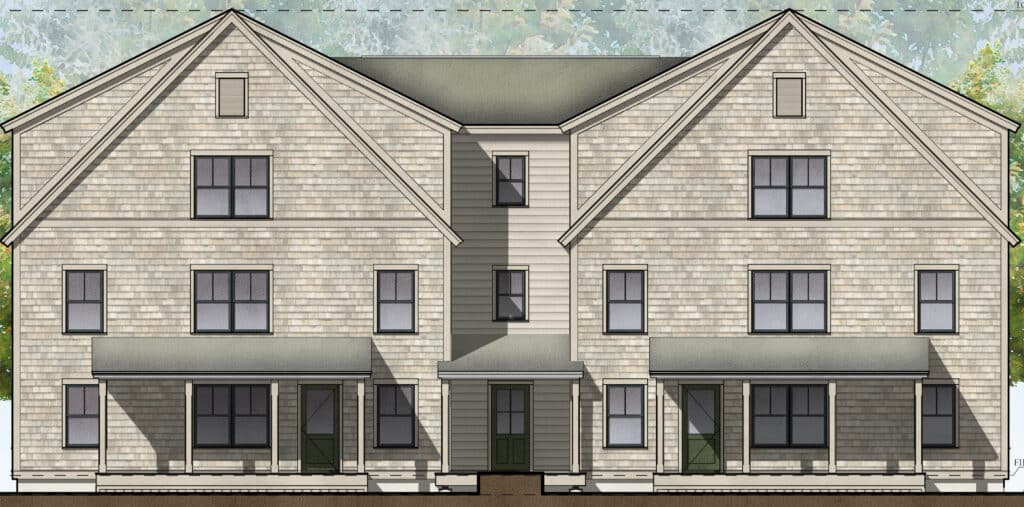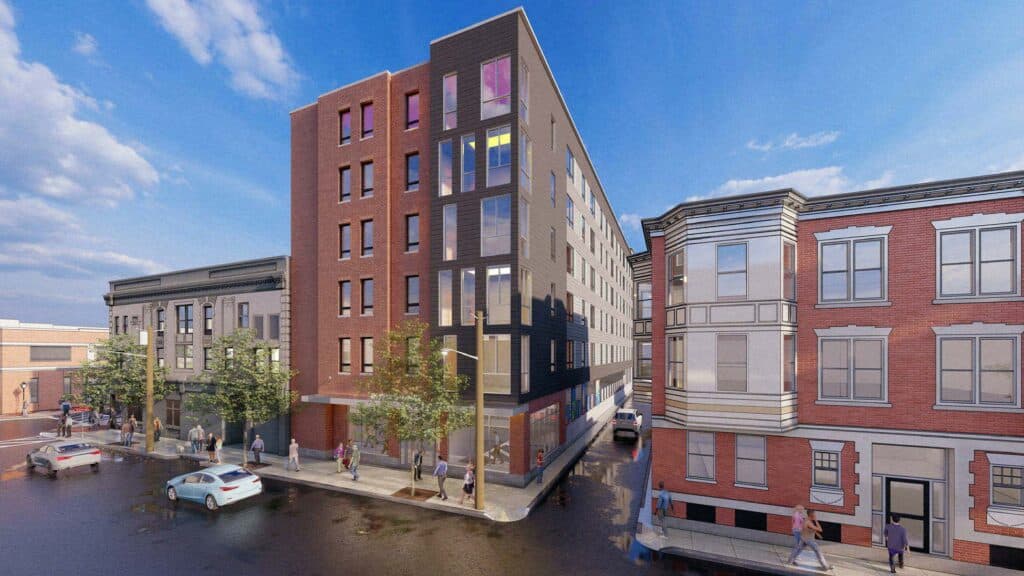
The Innes Apartments housing project in Chelsea replaced 96 low-income units and added 40 middle-income units, as well as 194 market-rate apartments. Officials broke ground on the project in October 2022. Cambridge Savings Bank was the lead lender, with other funding from the LIHTC program, Eastern Bank, Harbor One Bank and others. Photo by Mike Ritter | Courtesy of Chelsea Housing Authority
The passage of the legislation known as “The Big Beautiful Bill” makes changes to state tax credits that are likely to increase investment in multifamily development.
The bill permanently increases a state’s allocation of Low-Income Housing Tax Credits (LIHTCs) and lowers the bond-financing threshold, beginning in 2026. The tax credits help lower the cost of development, which is crucial in a high-cost environment.
“Developing any housing in a high-cost market like Massachusetts is incredibly expensive, from acquiring land to paying for labor and materials,” said Erin Nano, senior vice president and chief credit officer at Rollstone Bank. “If banks were to finance these projects solely with traditional loans and then charge market-rate rents, those rents would be far out of reach for the low-income families we aim to serve. This creates a situation where the amount of income and cash flow that affordable rents can generate is insufficient to support the development and financing costs of the project.”
Indeed, LIHTCs are almost always an essential component of affordable rental housing development.
“These tax credits are necessary to bridge the gap in keeping affordable housing as a growing component of the segment,” said Stephen DiPrete, South Shore Bank’s chief commercial banking officer. “Costs may continue to rise, whether it be interest rates, materials, labor – it’s critical for the entire process. The demand is there, the supply is very limited, and it’s only going to increase the impact.”
Along with the increase in the amount of housing tax credits, establishing some certainty regarding the program’s status gives banks more security to invest in these projects.
“I think that’s very important, predictability, because many of these projects do take some time in the planning stage,” DiPrete said. “[We] do a lot of predevelopment work, a lot of upfront time from both the bank side, the developer, everybody who’s involved, and to have that predictability going forward is going to allow a bank like us to definitely consider our investment in the program, both as a lender or as the construction lender.”

A 60-unit affordable and workforce housing development on Martha’s Vineyard recently broke ground. The project is supported by $27.3 million in state and federal low-income housing tax credits, as well as financing from MassHousing and others. Rockland Trust is the construction lender. Image courtesy of MassHousing
Increased Involvement
LIHTCs support the construction of affordable units in a high-cost markets like Massachusetts that are in dire need of inventory, and the BBB’s increase will allow banks to finance more projects.
“Because we’re owned by the community, we have certain obligations to the community,” said Aidan Hume, head of commercial real estate at Cambridge Savings Bank. Affordable housing is something we really see as an obligation, something we have to do to give back to the community. It’s something we do, we do it at so many different levels. We did a very, very large project in Chelsea a couple of years ago that replaced 96 public housing units with 330 units. Those 330 units were mostly market-rate, but they included the original 96 public housing units.”
DiPrete noted that demand will continue to be high for banks to be involved in the types of projects that utilize LIHTCs, leading to a more competitive market.
“The banks see that as a big positive, that there’s more equity in the project, and it makes it more of a bankable deal,” he said. “So it’ll attract more lenders, make it a more competitive market. On the side of the banks as a purchaser or a participant in buying these tax credits, it should improve availability, more predictability, because what you want is to know it’s a tool that you can continuously rotate into your portfolio. For banks in general, that should continue to be a positive, and create more opportunities from the business side of being a construction lender that’s involved in some of these tax credit incentive programs.”
There is also the potential for the increase in credits to expand beyond low-income housing development – most projects also include market-rate rental units.

MassHousing provided $10.6 million in financing to construction of 62 new rental units on Broadway in Chelsea. The development is also supported by $23.9 million in LIHTCs and other sources of funding. Image courtesy of MassHousing
“It also impacts the overall market in that there’s typically a number of market units that will come on board,” DiPrete said. “Newer projects bring a whole new supply of high-quality product, and that’s probably the most important thing.”
An increase in supply at any level is welcome in Massachusetts’ tight rental market, and may help regulate rents across the board.

Sam Minton
“This could be a step toward rents either leveling off, or maybe even coming down, or not increasing as fast, as well as improve the supply of newer units,” DiPrete said. “These projects tend to bring on the latest technology and sustainability. There’s a lot of associated benefits that go beyond just what the rent is, versus the amenities and the quality of the product.”
The original LIHTC program was a boon to developers, lenders and renters, Hume said, and increasing its reach will “hopefully plug that gap further to make it possible to do more affordable housing.”
“I’ve been in the business 30 years and multifamily has always been the most stable,” he said. “For years that was next to impossible to develop in many towns in Eastern Massachusetts. 40B and more recently, the MBTA Communities Act, changed that and really helped foster additional development.”





